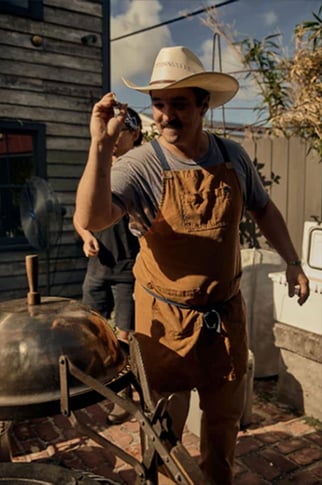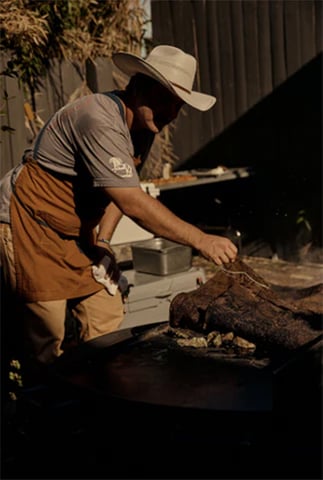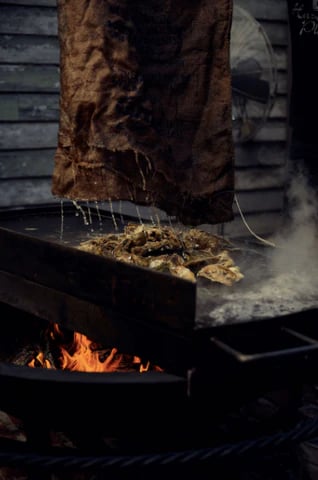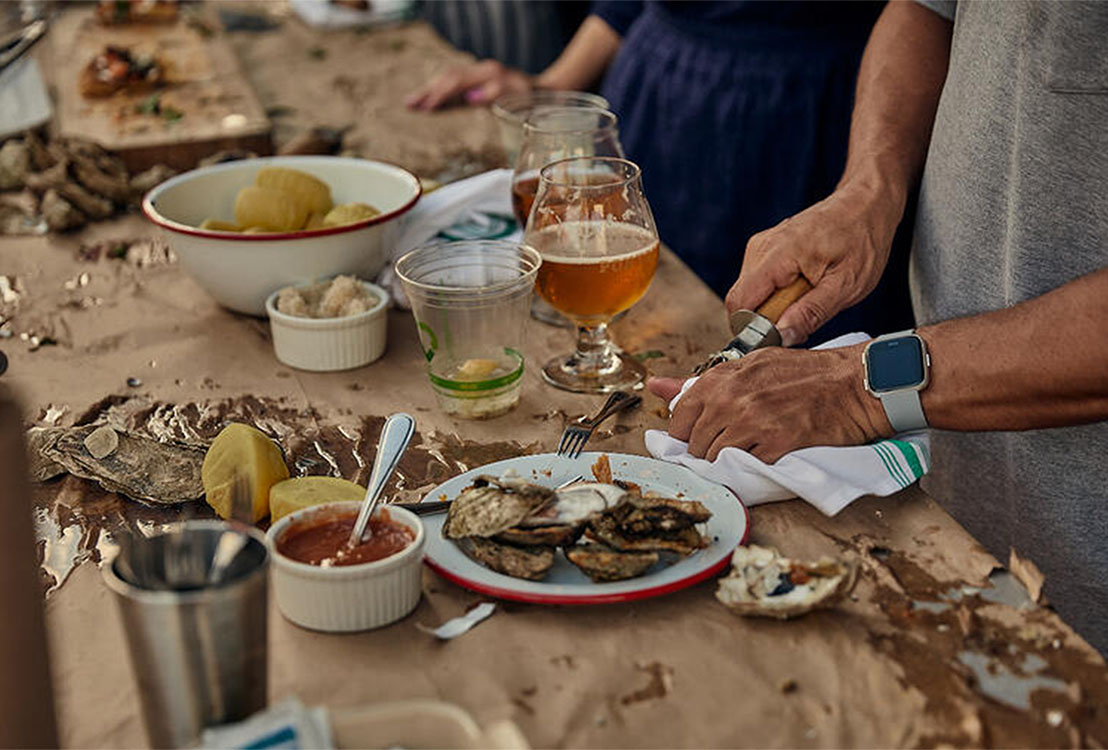THE HOT SEAT: Chef Jason Stanhope of Fig
January 21, 2020 by Sea Island Forge
By Stephanie Burt of The Southern Fork
It makes all the “best in Charleston lists,” it’s probably been suggested by two or more of your friends, but chances are, even after all the build up, a visit to FIG in Charleston, SC will live up -- or surpass -- that reputation. That’s in large part because of the steady hand of Chef Jason Stanhope on the helm, a James Beard Best Chef: South winner who loves to cook and loves to build a team that excels at every aspect of a restaurant experience. He learned valuable lessons under mentor and the restaurant’s partner/owner Mike Lata, and Stanhope’s unique attention to detail, big hearted appreciation of staff and guests, and simply fine food, perfectly sourced have elevated this exceptional neighborhood bistro to even loftier heights, where there’s always fresh catch, a seasonal appetizer to make you swoon, and gnocchi every night. But when the chef is home, he loves cooking outside in his own backyard, a space on James Island that he recently outfitted with its own SIF kettle.

Do you have a grilling or campfire memory that started your love of outdoor cooking?
I grew up in Kansas, and my father passed when I was 20. I didn’t really start cooking until after that, so he didn’t really see me cook, but I remember my dad grilling and smoking food all the time. He would smoke brisket before the [Kansas City] Chiefs games. I can remember the guys with Bud Lights, smoking cigars, and I loved being out there with him. His favorite old school grills were the OK Joe and the Hasty Bake.
What’s one meal that really shines on your SIF?
I’d really say it’s the pleasure of doing two. When we had the oyster roast for Ponysaurus Brewing, I used the hot plate (griddle top) for roasting oysters. And then I used that Dutch-oven style heat dome (on the grill top) to really direct some smoke for the smoked potatoes, which went so well with the roasted oysters. It’s so well crafted, and it performs so perfectly the whole time.
What is something you’ve cooked on the SIF that surprised you?
Smoked Potato Tarts. Not only could I cook the tart on the grill top, I could get some smoke on those fresh dug potatoes and move the grate around, move it over damp wood to really capture that smoke.
How would you describe your style of cooking?
FIG started as a farm-to-table bistro, but we tend to use deeply rooted European techniques and apply those to Southern ingredients. Our inspiration is the food coming in the door, and then we scramble like hell to get it on the menu. But … we are trying desperately to stay relevant precisely by celebrating classics and not manipulating those classic dishes and ingredients. In other words, we’re not making up dishes. We might be getting constant inspiration from ingredients, but everything [dish] we’re doing has a name.
What type of wood do you like for your SIF?
As far as keeping beautiful, constant heat, then it’s hardwood, and we have a lot of farmers and agricultural connections that have that available. But for flavor, I love fruit or pecan woods, something milder.
What’s something tricky about cooking on open fire that the average person needs to know?
To start the fire early and get it where you want it. It takes a while to build, probably longer than you are planning for, and you want to get it to the point where the embers are so steady.
What is your favorite element of the SIF?
I know it doesn’t sound like a big deal, but there is a tiny little backsplash on the plancha (griddle top) to make getting stuff off it so easy. It’s that attention to detail that I really appreciate. It’s beautiful.

The Perfect Lowcountry Oyster Roast
from Jason Stanhope, FIG, Charleston, SC
Editor’s note: This is more of a method than a strict recipes, but prepping for a stellar Lowcountry oyster roast is a learned art that involves planning and knowing how to enjoy a party.
Oysters
- Oyster clusters are traditional, and selects are pretty luxurious, so choose according to budget and crowd.
- Spray them down with the hose!
- Store in a cooler with a little loose ice and prop the lid open so the oysters can breathe. They are live animals.
Gear
- Gloves or towels. Shucking oysters can be dangerous!
- Oyster knives. Shop Sea Island Forge's Black Banks Oyster Knife here.
- A table outside, the taller the better. It could be as easy as particle board and saw horses.
- Trash can.
- Burlap bag, soaked in salted water.
- Shovel.
Upgrade opportunity: Plates and napkins are not necessary, but a roll of paper towels wouldn’t hurt. Or two.
Saltines
- If you are feeling fancy, preheat the oven to 350 degrees. If not, skip to number three.
- Remove saltines from sleeves, place on baking tray, then brush each cracker with melted butter and sprinkle with Old Bay seasoning, then bake until golden brown delicious.
- If not feeling it, place a few sleeves of saltines on table.
Other ingredients for the table
Cocktail Sauce
Upgrade Opportunity: The Ordinary’s Cocktail Sauce
1 pint ketchup
½ cup prepared horseradish
¼ cup Worcestershire
2 lemons, juiced
¼ cup Dijon mustard
1 tsp ground black pepper
Kosher salt to taste
Mix all ingredients in a bowl and adjust to your personal taste.
Mignonette
Upgrade Opportunity: The Ordinary’s Mignonette
2 shallots, minced
1 pint Red Wine Vinegar (better is better here)
1 tbsp ground black pepper
Mix all ingredients in a bowl.
- Prepared Horseradish
- Lemon Wedges
Beverages
- Lots of ice cold beer of your choice. Don’t get fancy here. I’m a fan of High Life or Bud Light.
- Don’t forget juice options for the kiddos and water.
- Place beer in one cooler, other options in the other so it will be easy.
Upgrade opportunity: Build your own bloody mary bar. That means celery, olives, black pepper, horseradish, Tabasco, bloody mix, Tito’s vodka, and ice; it’s basically cocktail sauce in vodka form.
Fire
Ehem…
Sea Island Forge Kettle with the plancha top (griddle top) is the crème de la crème of oyster roast essential.
When you’re ready to get the party started
- Start fire 1 hour before you need it. Build your coals and enjoy a cold beer.
- Wash oysters put them directly on the hot plancha (griddle top) in small batches, covering with wet burlap.
- Start out small and get into your groove. Have another cold beer.
- All oysters are a little different and some of us build fires hotter than others, so check them every couple of minutes. As soon as they barely start to open, remove the burlap, being very careful. The steam is sneaky hot!
- Quickly shovel oysters over to the table and pile in middle. (The back splash on the Sea Island Forge plancha (griddle top) makes this so operator friendly, as aforementioned.)
- Repeat until oysters are gone. Don’t run out of cold beer.
Grand Finale Upgrade Opportunity: My wife I have a favorite accoutrement to a cold-weather oyster roast: the imitable Frito Chili Pie. Here’s a great recipe from Taste of Home


